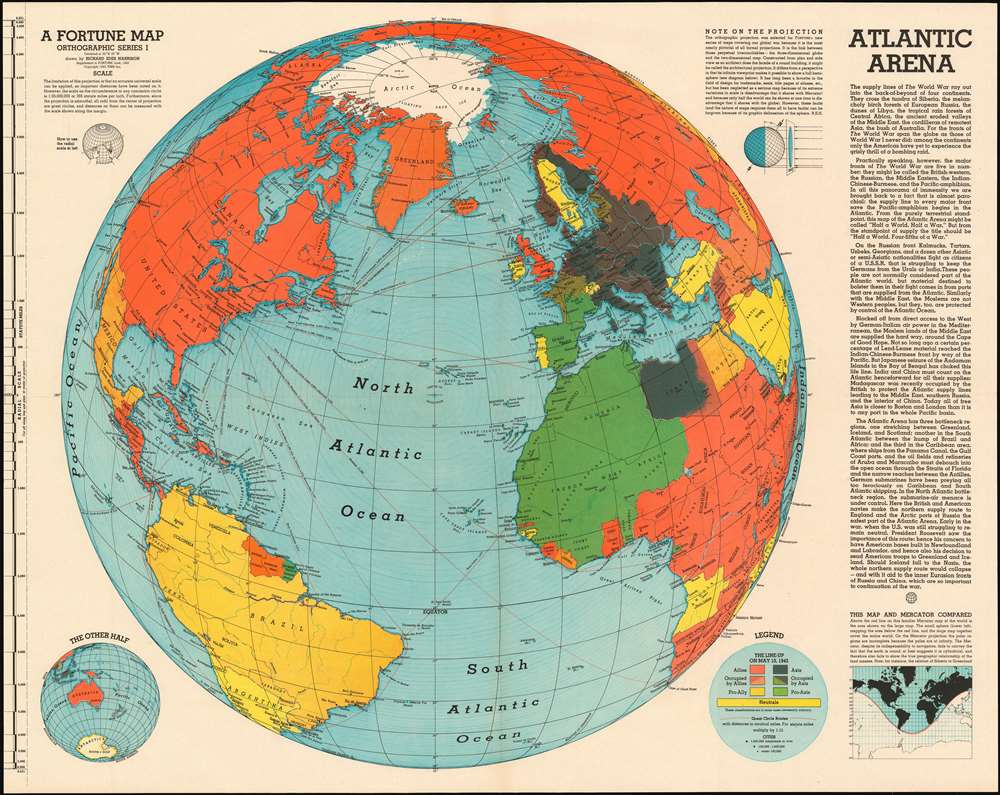1942 Richard Edes Harrison Map of the World during World War II
Atlantic-harrison-1942
Title
1942 (dated) 21 x 26.5 in (53.34 x 67.31 cm) 1 : 25000000
Description
The Projection
The map employs a unique orthographic projection, which, as Harrison himself notes on the map,is the most nearly pictorial of all formal projections... its infinite viewpoint makes it possible to show a full hemisphere... (It) has been neglected as a serious map because of its extreme variations in scale (a disadvantage it shares with Mercator) and because only half the world can be shown at one time (a disadvantage that it shares with the globe). However, these faults (and the nature of maps requires them all to have faults) can be forgiven because of its graphic delineation of the sphere. R.E.H.There are two inset maps: one titled 'The Other Half', which depicts the antipodes of the main map: Australia, Japan, China, Southeast Asia, the South Pacific, and Antarctica. and the other, titled 'This Map and Mercator Compared' shows the portion of the world visible on the orthographic projection marked in black on Mercator's venerable grid. Harrison's plumby discussion of the pros and cons of the projection make the use of the map more friendly, and perhaps add authority to the map's propagandistic content. In any case, the maps were clearly popular with Fortune's readership: this map would be just the first in a series of 'news maps' for both Fortune and the U.S. Government, intended to clarify the complex events of the war and make them comprehensible and palatable to the voting public.
Publication History and Census
This map was first published in 1942 as an insert in Fortune Magazine. It is well represented in institutional collections, with 25 listings in OCLC. It was included in the 1944 collection of Harrison's maps, 'Look At The World: The Fortune Atlas For world Strategy' (this later state includes a 1944 copyright on the verso.)Cartographer
Richard Edes Harrison (1902 - January 5, 1994) was an American cartographer and cartoonist active in the middle part of the 20th century. Harrison is credited with redefining cartography, especially journalistic cartography, by employing spherical perspective, bold shading, and graphic design to both make maps more publicly accessible and give them an artistic dimension. Harrison was born in Baltimore and studied design at Yale, graduating in 1923, before relocating to New York City at the height of the Great Depression. He made ends meet through industrial design work, creating everything from bottles to ashtrays. His first foray into the cartographic world was a fill-in job at Fortune magazine. The editors at Fortune must have admired his work for it launched a long-standing collaboration. His work, doubtless inspired by the age of air travel, became exceptionally popular during World War II, where his unique approach and political charged subject matter illustrated the seats of war with exceptional poignancy and clarity. After the war, Harrison continued to produce maps from his base in New York City. In his spare time he was an avid ornithologist and was commonly seen in Central Park in search of rare bird sightings. More by this mapmaker...

